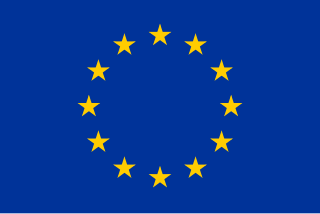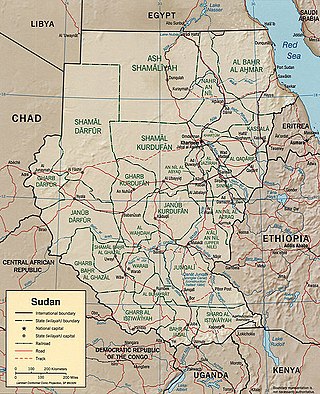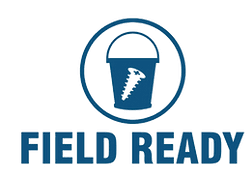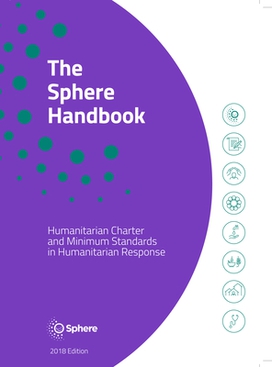Related Research Articles

CARE is a major international humanitarian agency delivering emergency relief and long-term international development projects. Founded in 1945, CARE is nonsectarian, impartial, and non-governmental. It is one of the largest and oldest humanitarian aid organizations focused on fighting global poverty. In 2019, CARE reported working in 104 countries, supporting 1,349 poverty-fighting projects and humanitarian aid projects, and reaching over 92.3 million people directly and 433.3 million people indirectly.

Humanitarian aid is material and logistic assistance, usually in the short-term, to people in need. Among the people in need are the homeless, refugees, and victims of natural disasters, wars, and famines. The primary objective of humanitarian aid is to save lives, alleviate suffering, and maintain human dignity.

The Directorate-General for European Civil Protection and Humanitarian Aid Operations, formerly known as the European Community Humanitarian Aid Office, is the European Commission's department for overseas humanitarian aid and for civil protection. It aims to save and preserve life, prevent and alleviate human suffering and safeguard the integrity and dignity of populations affected by natural disasters and man-made crises. Since September 2019, Janez Lenarčič is serving as Commissioner for Crisis Management in the Von der Leyen Commission, and since 1 March 2023, Maciej Popowski leads the organisation as the Director-General.

Islamic Relief Worldwide is a faith-inspired humanitarian and development agency which is working to support and empower the world's most vulnerable people.
Humanitarian assistance is aid and action designed to save lives, alleviate suffering, and maintain human dignity during and after man-made crises and disasters. It encompasses a wide range of activities, including providing food, water, shelter, medical care, and protection. Humanitarian assistance is grounded in the principles of humanity, impartiality, neutrality, and independence.
The British Red Cross Society is the United Kingdom body of the worldwide neutral and impartial humanitarian network the International Red Cross and Red Crescent Movement. The society was formed in 1870, and is a registered charity with more than 17,200 volunteers and 3,400 staff. At the heart of their work is providing help to people in crisis, both in the UK and overseas. The Red Cross is committed to helping people without discrimination, regardless of their ethnic origin, nationality, political beliefs or religion. Queen Elizabeth II was the patron of the society until her death in 2022, and was replaced by her successor King Charles III, who previously served as president between 2003 and 2024.

The United Nations Office for the Coordination of Humanitarian Affairs (OCHA) is a United Nations (UN) body established in December 1991 by the General Assembly to strengthen the international response to complex emergencies and natural disasters. It is the successor to the Office of the United Nations Disaster Relief Coordinator (UNDRO).

Operation Lifeline Sudan (OLS) was a consortium of United Nations agencies and approximately 35 non-governmental organizations operating in southern Sudan to provide humanitarian assistance throughout war-torn and drought-afflicted regions in the South. Operation Lifeline Sudan was established in April 1989 in response to a devastating war-induced famine and other humanitarian consequences of the Second Sudanese Civil War between the Sudanese government and South Sudanese rebels. It was the result of negotiations between the UN, the Government of Sudan and the Sudan People's Liberation Movement/Army (SPLM/A) to deliver humanitarian assistance to all civilians in need, regardless of their location or political affiliation. This included over 100,000 returnees from Itang in Ethiopia in 1991. Lokichogio was the primary forward operations hub for OLS.
Medical Emergency Relief International (Merlin) is a former British international non-governmental health charity which sends medical experts to global emergencies.

Medair is an international non-governmental organisation (INGO) whose purpose is to relieve human suffering in some of the world's most remote and devastated places. Medair aims to assist people affected by natural disasters and conflict to recover with dignity through the delivery of quality humanitarian aid.

Acted is a French international solidarity non-governmental organization (NGO), founded in 1993. It is headquartered in Paris.

Humanity First is an international charity that provides disaster relief and long term development assistance to vulnerable communities in 52 countries across 6 continents. The organisation is run by volunteers with diverse skillsets across the world and has access to thousands of extra volunteers worldwide. Volunteer staff in all areas often pay their own expenses to support the international projects.
The Sudanese Red Crescent (SRC) is the biggest and most decentralized and widespread humanitarian organization operating in Sudan. The society developed out of the Sudan branch of the British Red Cross Society and was established in 1956. Upon Sudan's independence in March 1956 received official recognition as an independent National Society following the Sudanese Council of Ministers decree No. 869. The National Society covers nearly the entire country with 15 State branches and several sub-branches/units in the provinces/localities and administrative units, with a nationwide community-based network of 35,000 active volunteers and another 300,000 who can be deployed as need arises. It has well-established working relations with public authorities at federal, state and local levels, and good partnership and collaboration with Movement partners and UN specialized agencies and national and international NGOs working in Sudan.

New Zealand Red Cross or Rīpeka Whero Aotearoa is a humanitarian organisation, which has more than 9,000 members and volunteers. In New Zealand, Red Cross delivers core community services, such as Meals on Wheels, refugee re-settlement services, first aid courses, and emergency management operations. Internationally, New Zealand Red Cross sends international delegates overseas to assist in areas where humanitarian assistance is needed, this includes disaster preparedness and response. In 2013, 17 delegates were sent to the Philippines in the aftermath of Typhoon Haiyan and in 2014, 18 New Zealand delegates responded to the Ebola epidemic in West Africa.

Humanitarian Accountability Partnership International, established in 2003, was the humanitarian sector's first international self-regulatory body. A multi-agency initiative working to improve the accountability of humanitarian action to people affected by disasters and other crises, HAP members ranged from organisations with a mandate for emergency relief and development activities to institutional donors. The organisation aimed to strengthen accountability towards those affected by crisis situations and to facilitate improved performance within the humanitarian sector. The ultimate goal of the organisation was to uphold the rights and the dignity of crisis-affected populations across the world.
People In Aid was an international, not-for-profit membership organisation with offices in the UK, Australia and East Africa. People In Aid no longer exists following its merger with HAP International on 9 June 2015 to form the CHS Alliance.

Organizations from around the world responded to the West African Ebola virus epidemic. In July 2014, the World Health Organization (WHO) convened an emergency meeting with health ministers from eleven countries and announced collaboration on a strategy to co-ordinate technical support to combat the epidemic. In August, they declared the outbreak an international public health emergency and published a roadmap to guide and coordinate the international response to the outbreak, aiming to stop ongoing Ebola transmission worldwide within 6–9 months. In September, the United Nations Security Council declared the Ebola virus outbreak in the West Africa subregion a "threat to international peace and security" and unanimously adopted a resolution urging UN member states to provide more resources to fight the outbreak; the WHO stated that the cost for combating the epidemic will be a minimum of $1 billion.
Evidence Aid is an international platform that was formed out of the need to deliver time sensitive access to systematic reviews for use in the event of disasters and other humanitarian emergencies. The method of using systematic reviews is to provide evidence for use by policy makers, clinicians, regulators, and even the general public who benefit when these materials are easy to understand and are accessible. The vision of Evidence Aid is to create and satisfy an increasing demand for evidence to improve the impact of humanitarian aid by stimulating the use of an evidence-based approach. Evidence Aid was founded in 2004. It is currently a project that is housed by the Cochrane Collaboration and Queen's University Belfast. Evidence Aid was established by several members of the international Cochrane Collaboration following the 2004 Indian Ocean earthquake and tsunami. Evidence Aid was formed to provide systematic reviews on the effects of interventions and actions of relevance prior to, in the course of and during the aftermath of disasters or other humanitarian emergencies, in order to improve health-related outcomes; their aim is to work with those who need and use this evidence, as well as working with researchers and publishers to facilitate freely accessible materials to meet the information needs for those facing humanitarian emergencies and disasters. Evidence Aid works in collaboration with other organizations including Public Health England; Red Cross Flanders, International Rescue Committee; Centers for Disease Control; Centre for Evidence-Based Medicine; and the University of Oxford.

Field Ready is a non-profit, global humanitarian aid and development, non governmental organization that helps provide critical items and training to people when they are in need of them.

The Sphere Handbook: Humanitarian Charter and Minimum Standards in Humanitarian Response often called the Sphere Standards is a textbook of minimum standards in humanitarian aid published by the Sphere Association.
References
- ↑ "RedR International: Humanitarian training for NGOs and aid workers worldwide". RedR. Retrieved 2019-04-09.
- 1 2 Our History, RedR
- ↑ ICE News, New Civil Engineer
- ↑ "Building humanitarian capacity since 1980". RedR. Retrieved 2019-06-07.
- ↑ "About Us". www.redr.org.au. Archived from the original on 2010-06-28.
- ↑ "Building humanitarian capacity since 1980". RedR. Retrieved 2019-06-07.
- ↑ "RedR NZ - History". Archived from the original on 2014-05-19. Retrieved 2014-05-17.
- ↑ Davis, Jan; Lambert, Robert (1995). Engineering in Emergencies. Rugby, Warwickshire, United Kingdom: Practical Action Publishing. doi:10.3362/9781780441139. ISBN 978-1-85339-521-5.
- ↑ "Building humanitarian capacity since 1980". RedR. Retrieved 2019-06-07.
- ↑ "Building humanitarian capacity since 1980". RedR. Retrieved 2019-06-07.
- ↑ "RedR and IHE merger". fex.ennonline.net. Archived from the original on 2012-04-25.
- ↑ "Building humanitarian capacity since 1980". RedR. Retrieved 2019-06-07.
- 1 2 3 4 5 6 7 8 9 10 11 12 13 14 15 16 "Expert training and learning for the humanitarian sector". RedR. Retrieved 2019-06-07.
- ↑ "Building humanitarian capacity since 1980". RedR. Retrieved 2019-06-07.
- 1 2 "Disaster relief training gains professional recognition — Oxford Brookes University". www.brookes.ac.uk. Archived from the original on 2010-12-22.
- 1 2 3 4 5 "The latest updates on our humanitarian work around the world". RedR. Retrieved 2019-06-07.
- ↑ Press Release. "Second cohort of NHS volunteers gear up to fight Ebola in West Africa". gov.uk/government/news. gov.uk. Retrieved 26 January 2015.
- ↑ Redr. "WEST AFRICA: EBOLA VIRUS". redr.org.uk. RedR UK. Retrieved 26 January 2015.
- ↑ "Who We Are". www.redr.org.au. Retrieved 2024-01-05.
- 1 2 3 4 5 6 7 8 9 "RedR Australia Annual Report FY23" (PDF). Retrieved 5 January 2024.
- ↑ "RedR Australia 2017/18 Annual Report" (PDF). Retrieved 5 January 2024.
- ↑ "About Australia Assists". www.redr.org.au. Retrieved 2024-01-05.
- ↑ "Australia Assists" . Retrieved 5 January 2024.
- ↑ "Australia Assists Annual Report FY23" (PDF). Retrieved 5 January 2024.
- ↑ "Australia Assists". redr.org.au. Retrieved 2024-01-05.
- ↑ "About our Training". www.redr.org.au. Retrieved 2024-01-05.
- ↑ "United Nations Standby Partnership". www.redr.org.au. Retrieved 2024-01-05.
- ↑ "Dr Helen Durham AO". www.vic.gov.au. 2023-12-22. Retrieved 2024-01-05.
- ↑ Development, PodBean. "Humanitarian Conversations | a podcast by RedR Australia". humanitarianconversations.podbean.com. Retrieved 2024-01-05.
- 1 2 3 "Thomson Reuters Foundation" . Retrieved 2020-01-09.
- ↑ "Pakistan | IDMC". www.internal-displacement.org. Retrieved 2019-06-07.
- ↑ "RedR launches East Africa Appeal as ten million face severe hunger - AlertNet". m.trust.org. Archived from the original on 2012-03-30.
- ↑ http://www.thelordmayorsappeal.org.uk/news/readmore/48 [ dead link ]
- ↑ http://reliefweb.int/node/444959 [ dead link ]
- 1 2 3 "Our vision: A world where sufficient competent and committed personnel are responding to humanitarian needs". RedR. Retrieved 2019-06-07.